

WIFI 7 Click board example on SAM E51 Curiosity Nano Evaluation Kit
Download
Description:
This example demonstrates the WiFi capability of WiFi 7 Click board on SAM E51 Curiosity Nano Evaluation Kit.
This application scans for available Access Points and display the list on tera term. It sends out a scan requests and lists responses of all Access points along with their signal strength and connects to the specified Access point.
Modules/Technology Used:
- Peripheral Modules
- GPIO
- SERCOM (SPI)
- SERCOM (UART)
- Core
- SPI Driver
- WINC
- Timer system service
- TC0
- Console system service
- Debug system service
ATWINC1510 Firmware upgrade Guide
Refer the documentation in utilities folder
If this is the first time you are building/running this version of the demo, you must complete this step before proceeding further. Otherwise, you may skip this step.
Hardware Used:
- SAM E51 Curiosity Nano Evaluation Kit
- Curiosity Nano Base for Click Boards
- MikroElektronika WIFI 7 CLICK
Software/Tools Used:
This project has been verified to work with the following versions of software tools:
Refer Project Manifest present in harmony-manifest-success.yml under the project folder firmware/src/config/sam_e51_cnano
- Refer the Release Notes to know the MPLAB X IDE and MCC Plugin version. Alternatively, Click Here
- Any Serial Terminal application like Tera Term terminal application.
Because Microchip regularly update tools, occasionally issue(s) could be discovered while using the newer versions of the tools. If the project doesn’t seem to work and version incompatibility is suspected, It is recommended to double-check and use the same versions that the project was tested with. To download original version of MPLAB Harmony v3 packages, refer to document How to Use the MPLAB Harmony v3 Project Manifest Feature
Setup:
- Connect the SAM E51 Curiosity Nano Evaluation Kit to the Host PC as a USB Device through a Type-A male to micro-B USB cable connected to Micro-B USB (Debug USB) port
-
Mount the WiFi 7 click board on mikroBUS connector 1 of Curiosity Nano Base

Programming hex file:
The pre-built hex file can be programmed by following the below steps.
Steps to program the hex file
- Open MPLAB X IDE
- Close all existing projects in IDE, if any project is opened.
- Go to File -> Import -> Hex/ELF File
- In the “Import Image File” window, Step 1 - Create Prebuilt Project, Click the “Browse” button to select the prebuilt hex file.
- Select Device has “ATSAME51J20A”
- Ensure the proper tool is selected under “Hardware Tool”
- Click on Next button
- In the “Import Image File” window, Step 2 - Select Project Name and Folder, select appropriate project name and folder
- Click on Finish button
- In MPLAB X IDE, click on “Make and Program Device” Button. The device gets programmed in sometime
- Follow the steps in “Running the Demo” section below
Programming/Debugging Application Project:
- Open the project (wifi_7/firmware/sam_e51_cnano.X) in MPLAB X IDE
- Ensure “SAM E51 Curiosity Nano” is selected as hardware tool to program/debug the application
- Build the code and program the device by clicking on the “make and program” button in MPLAB X IDE tool bar
- Follow the steps in “Running the Demo” section below
Running the Demo:
- Configure the serial port terminal with 9600 baud rate
- After power up, when the demo is running, the application prints as shown below
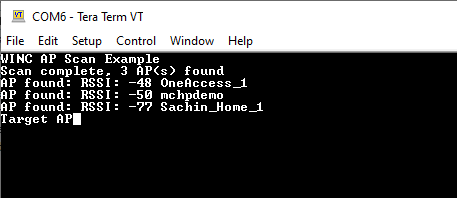
-
Change the SSID and Password of your known WiFi credentials in “wifi_7.h” header file and reprogram the project

- Device connects to the specified WiFi Access Point
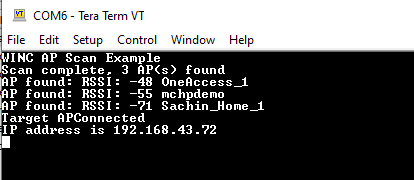
Instructions to add WiFi 7 click functionality to your application:
The MPLAB Harmony v3 supports adding WiFi functionality to your application using WINC driver.
Below are Harmony v3 configuration for the WiFi 7 click
- Connect the WINC components as shown in the below figure
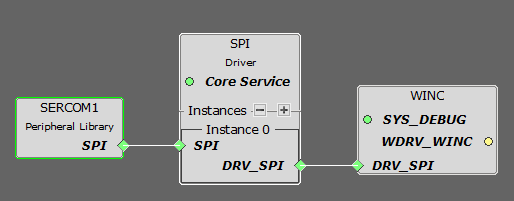
- Change Configuration of components as shown in the below figures
- SERCOM1 Configuration
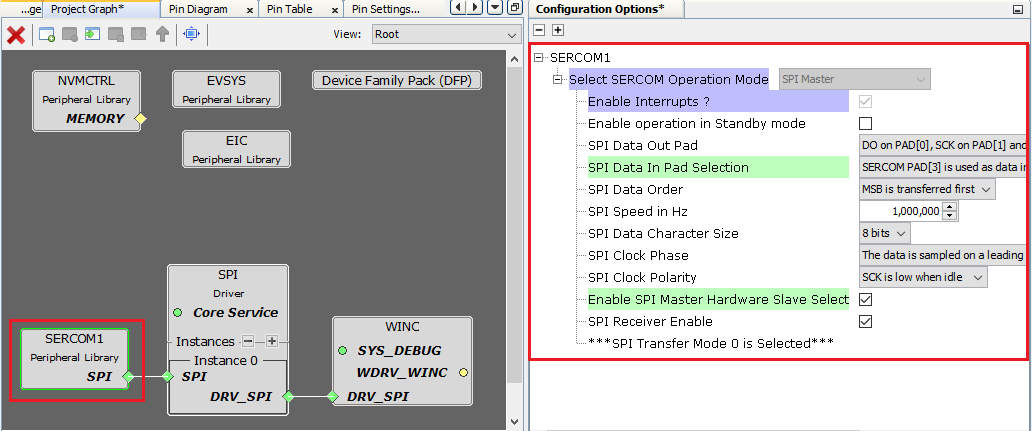
- MCC Pin Configurator - SPI pin configuration

- MCC Pin Configurator - additional pin configurations

- WINC configuration
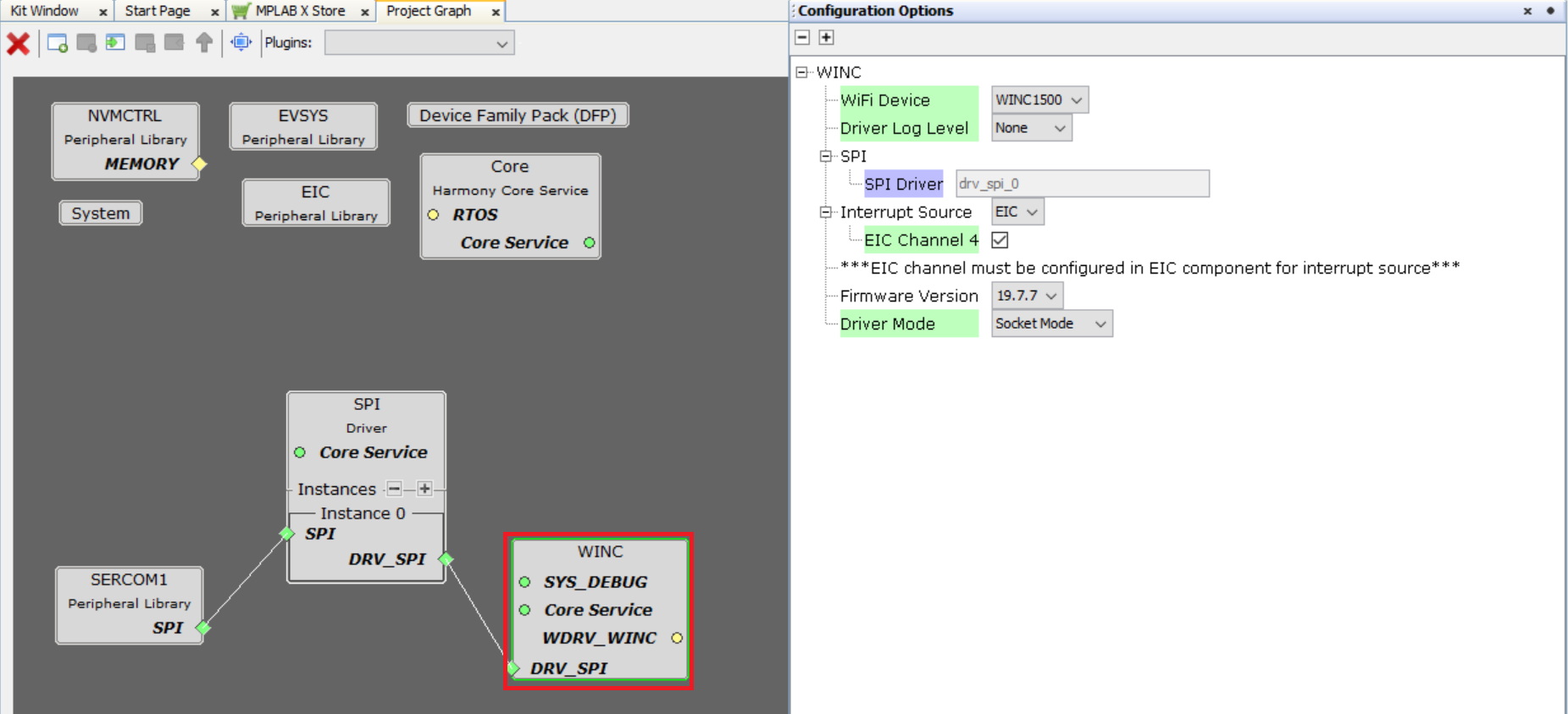
- SERCOM1 Configuration
- Change Configuration of components as shown in the below figures
Note : Other components’ configurations will be default
- Connect the console and debug system service necessary for WINC driver as shown in the below figure
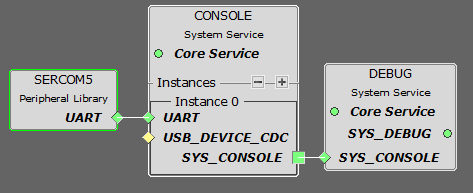
- SERCOM5 Configuration
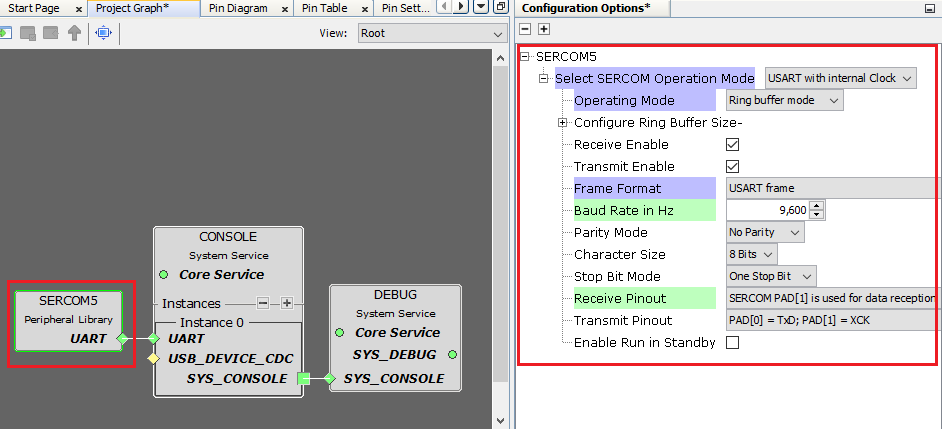 - MCC Pin Configurator - UART pin configuration
- MCC Pin Configurator - UART pin configuration

- Debug Configuration
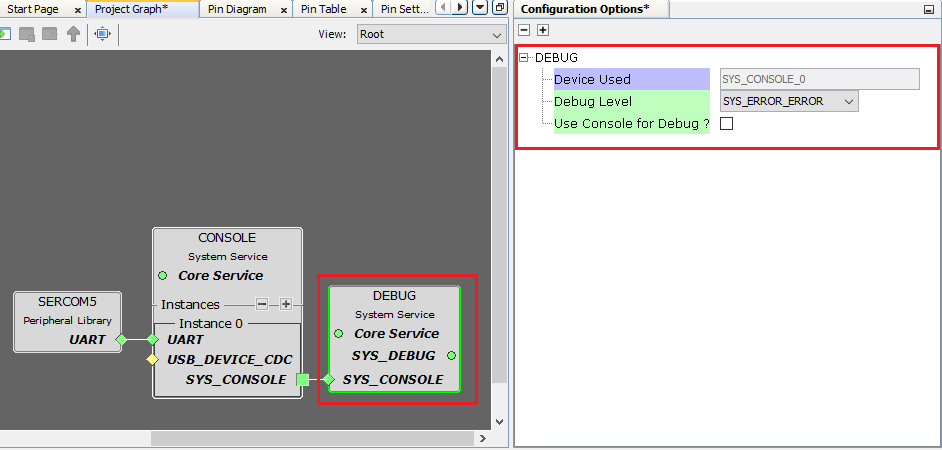
- Enable timer system service and core service as needed by the WINC driver

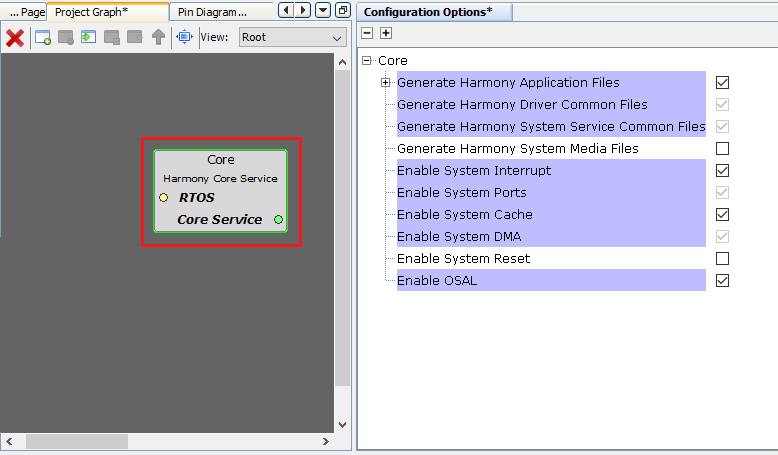
- Configure the EIC as shown in the below figure
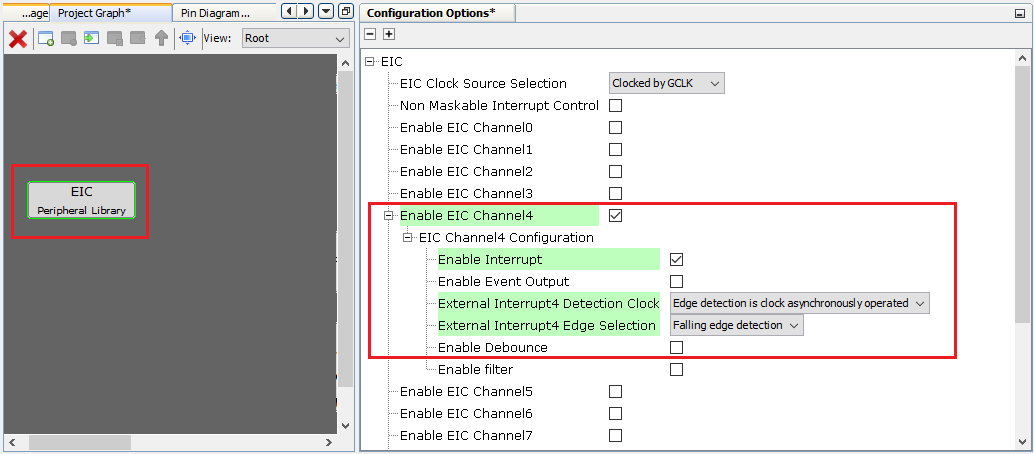
- You could use this demonstration as an example to add WiFi 7 click functionality to your MPLAB Harmony v3 based application. Follow the below steps.
Note: This demo can be extended to connect to web to transfer data, refer the reference section below for more applications
- If you haven’t downloaded the WiFi 7 click demo yet Click Here to download, otherwise go to next step
- Unzip the downloaded .zip file
- From the unzipped folder wifi_7/firmware/src, copy the folder click_routines to the folder firmware/src under your MPLAB Harmony v3 application project
- Open MPLAB X IDE
- Open your application project
- In the project explorer, Right click on folder Header Files
and add a sub folder click_routines by selecting “Add Existing Items from Folders…”
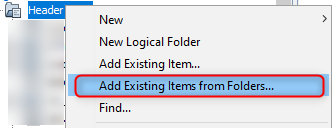
-
Click on “Add Folder…” button

-
Select the “click_routines” folder and select “Files of Types” as Header Files
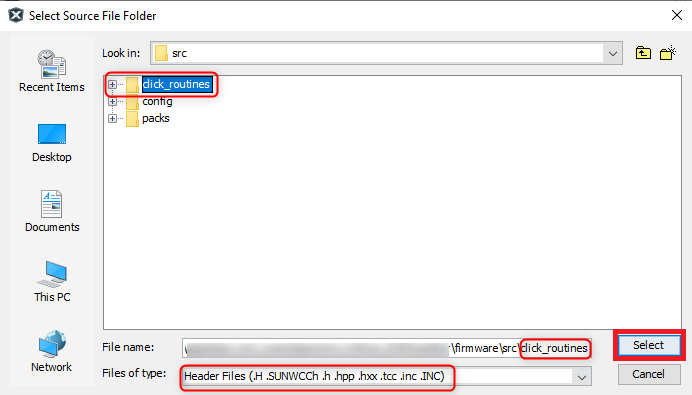
-
Click on “Add” button to add the selected folder
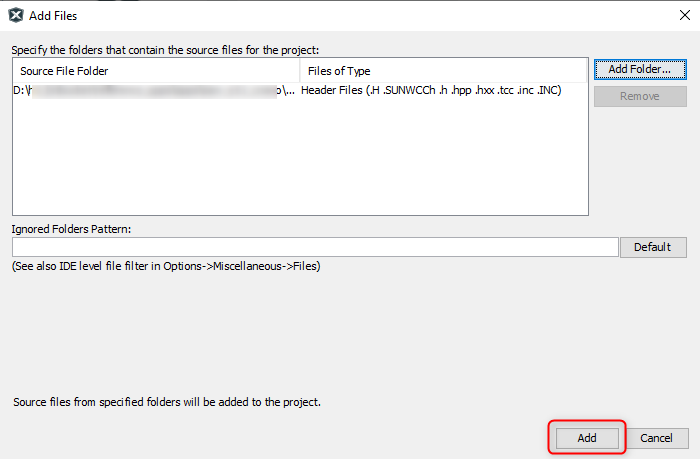
-
The WiFi 7 click header files gets added to your project
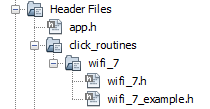
- In the project explorer, Right click on folder Source Files
and add a sub folder click_routines by selecting “Add Existing Items from Folders…”
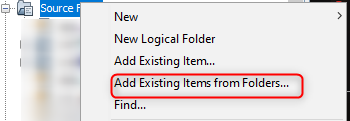
-
Click on “Add Folder…” button

-
Select the “click_routines” folder and select “Files of Types” as Source Files
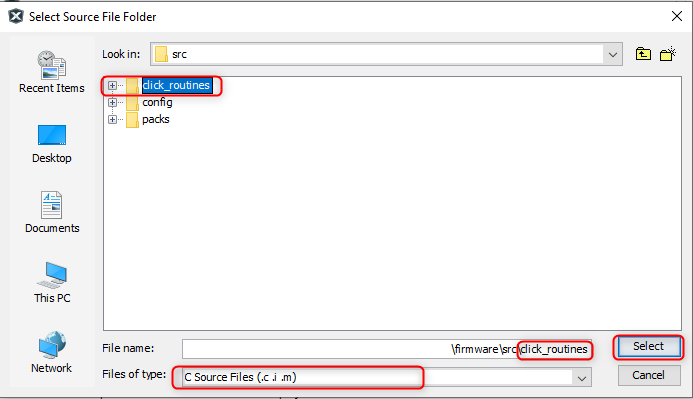
-
Click on “Add” button to add the selected folder

-
The WiFi 7 click source files gets added to your project
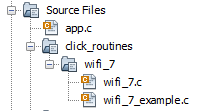
- SERCOM5 Configuration
- The click_routines folder contain an example C source file wifi_7_example.c. You could use wifi_7_example.c as a reference to add WiFi 7 display functionality to your application.
Comments:
- Reference Training Module:
- Getting Started with Harmony v3 Peripheral Libraries on SAM D5x/E5x MCUs
- Low Power Application on SAM E54 (Arm® Cortex® M4) MCUs Using MPLAB® Harmony v3 Peripheral Libraries
- Getting Started with Harmony v3 Drivers on SAM E54 MCUs Using FreeRTOS
- Google Cloud IoT Core Application on SAM E51 Curiosity Nano Evaluation Kit using Socket mode
- Vending Machine Application on SAM E54 Xplained Pro Evaluation Kit using TCP/IP mode
- This application demo builds and works out of box by following the instructions above in “Running the Demo” section. If you need to enhance/customize this application demo, you need to use the MPLAB Harmony v3 Software framework. Refer links below to setup and build your applications using MPLAB Harmony.
- How to Setup MPLAB Harmony v3 Software Development Framework
- How to Build an Application by Adding a New PLIB, Driver, or Middleware to an Existing MPLAB Harmony v3 Project
- MPLAB Harmony v3 is also configurable through MPLAB Code Configurator (MCC). Refer to the below links for specific instructions to use MPLAB Harmony v3 with MCC.
Revision:
- v1.6.0 - Updated steps to upgrade ATWINC1510 firmware. Regenerated and Tested the application.
- v1.5.0 - Removed MHC support, regenerated and tested application.
- v1.4.0 - Released demo application